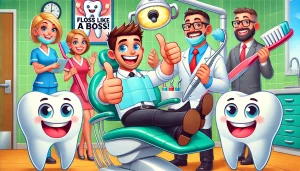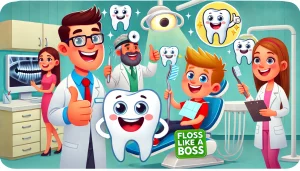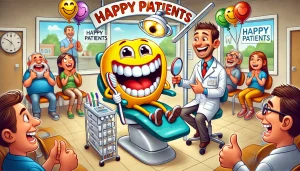Dental patient satisfaction: Improve your patients experience

Understanding what makes your patients happy is essential, and the best way to achieve this is by asking them directly. A dental patient survey is an excellent tool to gain insights into why patients continue to choose your practice and to learn about those who had less favorable experiences.
However, when conducting dental surveys, it’s crucial to avoid common mistakes and follow best practices to maximize their effectiveness.
Common mistakes in dental patient surveys
Asking too many questions
Overloading your survey with questions can frustrate patients and lead them to abandon the survey before completing it. Focus on extracting the most useful information with as few questions as possible.
Having too many mandatory questions
Mandatory questions can be perceived as intrusive, causing patients to lose interest in the survey. Highlight the critical questions and make the rest optional to ensure you receive more authentic feedback.
Including too many open-ended questions
While open-ended questions allow patients to share detailed experiences, too many of them can make the survey feel burdensome. Use them sparingly to gather in-depth insights without overwhelming respondents.
Getting too personal too early
Asking for personal information such as age, gender, or education level at the beginning of the survey can be off-putting. If these questions are necessary, place them at the end and ensure they serve a clear business goal.
Not acting on feedback
Responding promptly to patient feedback is crucial. Show your patients that you value their opinions and are committed to making improvements.
Acknowledge satisfied patients and express gratitude for their feedback to reinforce their loyalty.
Maximizing survey effectiveness
Keep it short and relevant
Focus on the most pertinent questions to avoid overwhelming your patients.
Balance question types
Use a mix of mandatory and optional questions, along with a few open-ended ones, to capture comprehensive feedback without causing survey fatigue.
Respect privacy
Save personal questions for the end and only include them if they are essential for your analysis.
Act on feedback
Show your patients that their feedback matters by making visible improvements and thanking them for their input.
Addressing issues proactively
Surveys provide an opportunity to address issues before they escalate into negative online reviews. Many dental practices share online patient surveys post-visit to gauge patient satisfaction.
However, sending out numerous surveys doesn’t guarantee a high response rate. To improve participation, avoid the common mistakes mentioned above.
Dental survey tips
Keep the survey simple and concise
Avoid lengthy or overly detailed surveys as they may deter patient participation. Focus on simple, pertinent questions to ensure you gather essential information without overwhelming your patients.
Include a suggestion section
Provide a space for patients to offer suggestions. This allows you to directly see what aspects of your office need improvement and which areas are performing well.
Encouraging feedback on both strengths and areas needing improvement can provide a balanced view of patient satisfaction.
Ask impactful questions
Ensure that the questions asked can lead to actionable insights. Avoid “fluff” questions that do not contribute to meaningful improvements in your practice.
Act on patient suggestions
Utilize the feedback to make real changes in your practice. Implementing patient suggestions, whether simple or complex, demonstrates your commitment to improving their experience.
Commit to continuous improvement
Regularly conducting and analyzing surveys can help you stay attuned to patient needs and enhance their satisfaction over time. Continuous feedback loops can lead to a more successful practice and happier patients.

Understanding the importance of patient satisfaction
Patient satisfaction extends beyond delivering treatment; it encompasses the entire patient experience, from booking appointments to billing. Satisfied patients are more likely to return, refer others, and leave positive reviews, all contributing to the growth of your practice.
Benefits of high patient satisfaction:
Increased patient retention and loyalty.
Better compliance with treatment plans, leading to improved oral health outcomes.
Enhanced reputation and positive word-of-mouth referrals.
Key metrics for measuring patient satisfaction
Effectively measuring and improving patient satisfaction requires a combination of metrics and methodologies:
Patient surveys
Conduct surveys after each visit to gather feedback on waiting times, staff communication, quality of care, and overall satisfaction. Email and text message surveys are effective tools for this purpose.
Net promoter score (NPS)
Measure the likelihood of patients recommending your practice. Patients rate their likelihood on a scale from 0 to 10, with scores of 9 or 10 being promoters and scores of 6 or below being detractors.
The NPS is calculated by subtracting the percentage of detractors from the percentage of promoters.
Online reviews and ratings
Monitor platforms like Google My Business, Yelp, and Healthgrades for insights into patient satisfaction. Positive reviews enhance your reputation, while negative reviews should be addressed promptly.
Wait times
Long wait times can negatively impact satisfaction. Efficient appointment scheduling and workflow management can help minimize wait times and improve the patient experience.
Strategies for improving patient satisfaction
Once patient satisfaction metrics have been collected, it’s essential to act on the insights to drive continuous improvement:
Address feedback promptly
Acknowledge both positive and negative feedback. Implement changes based on feedback to show patients that their opinions are valued and considered.
Create a comfortable environment
Alleviate patient anxiety by creating a welcoming and calming atmosphere. Comfortable seating, soothing music, and amenities like water and reading materials can enhance the patient experience.
Personalize the experience
Build rapport and loyalty by personalizing interactions. Show genuine interest in patients’ lives beyond their dental needs, which can foster stronger patient relationships.
Enhance communication
Clear and empathetic communication is crucial. Ensure that patients understand their treatment options, follow-up care, and receive timely appointment reminders.
Set CX goals and milestones with staff
Align your team with clear customer experience goals. Involve staff in goal-setting to empower them in contributing to improved patient satisfaction.
Track performance across teams
Analyze metrics like NPS scores, survey responses, and online reviews to identify trends and areas for improvement. Use data-driven insights to standardize and innovate practices across locations.
Benefits of using dental patient feedback surveys
Gain valuable insights
Understand patient perspectives on care quality, identify areas for improvement, and highlight strengths to replicate across the practice.
Increase satisfaction and retention rates
Addressing patient concerns improves satisfaction, leading to higher retention rates. Retaining existing patients is more cost-effective than acquiring new ones.
Improve communication and build trust
Using feedback to make positive changes demonstrates that you value patient opinions, fostering trust and credibility.
Boost your reputation
Active reputation management through addressing feedback can enhance patient retention and attract new patients.
Identify unique selling points
Recognize what sets your practice apart and market these strengths to attract new patients. Engaging initiatives like patient giveaways can also improve satisfaction.
Getting started with patient surveys
Patient surveys are valuable tools for enhancing dental practices by providing insights into patient sentiment. If creating effective surveys seems challenging, consider using services, which can help you design engaging, non-intrusive, and concise surveys that your patients will be eager to complete.
Additionally, explore the top six dentist review sites to prioritize for gathering and showcasing patient feedback.
By avoiding common pitfalls and focusing on creating meaningful surveys, dental practices can better meet patient needs, enhance service quality, and boost patient retention.
Patient feedback surveys are essential tools for building a successful dental practice. They provide critical insights that, when acted upon, can lead to improved patient experiences, higher satisfaction rates, and overall practice growth.
Utilizing professional tools and strategies for continuous improvement ensures that your practice thrives and meets the evolving needs of your patients.

Numbers and facts
Appointment scheduling and accessibility
Ease of scheduling: 85% of patients reported satisfaction with the ease of scheduling appointments.
Wait times: 78% of patients were satisfied with the waiting times, both for scheduling appointments and in-office wait times.
Online booking: 65% of respondents used online booking systems, with 90% satisfaction in this group.
Staff professionalism and communication
Professionalism of staff: 92% of patients felt that the dental staff were professional and courteous.
Communication: 88% of patients were satisfied with the clarity of communication regarding their dental care and procedures.
Facility cleanliness and comfort
Cleanliness: 95% of patients rated the cleanliness of the facility as excellent.
Comfort: 82% of patients felt comfortable and at ease in the dental office environment.
Quality of dental care
Treatment satisfaction: 89% of patients were satisfied with the quality of dental care they received.
Pain management: 84% of patients reported effective pain management during and after procedures.
Post-treatment care: 76% of patients were satisfied with the follow-up care and instructions provided.
Areas for improvement
Wait times: While 78% satisfaction is high, reducing in-office wait times could further improve patient experience.
Post-treatment communication: Enhancing the clarity and frequency of post-treatment follow-up could improve the 76% satisfaction rate.
Technological integration: Increasing the use of advanced technologies such as digital impressions and tele-dentistry could boost patient satisfaction.
The dental patient satisfaction survey indicates high overall satisfaction across various dimensions of dental care. Continuous efforts to reduce wait times, improve post-treatment communication, and integrate new technologies will further enhance patient experiences and satisfaction levels.
Recommendations
Implement strategies to minimize wait times, such as efficient scheduling systems and better patient flow management.
Provide clear and detailed post-treatment care instructions and ensure follow-up communication.
Invest in modern dental technologies to improve treatment outcomes and patient experiences.
By focusing on these areas, dental practices can achieve higher patient satisfaction, leading to better patient retention and positive word-of-mouth referrals.

Expert opinions on dental patient survey
Dr. Emily Hargrove, DDS: “A well-designed dental patient satisfaction survey can reveal critical insights into patient experiences. It helps us understand not only the clinical aspects but also the emotional and psychological factors that affect patient satisfaction. By asking the right questions, we can identify areas needing improvement, from appointment scheduling to the cleanliness of our facilities.”
Dr. James Thompson, Pediatric dentist: “In pediatric dentistry, a child’s experience can significantly influence their lifelong attitude toward dental care. Satisfaction surveys tailored to parents and children can provide insights into how well we are addressing the unique needs of our young patients. From managing dental anxiety to creating a child-friendly environment, this feedback is instrumental in improving our services.”
Dr. William Chen, General dentist: “As a general dentist, I find patient satisfaction surveys to be an indispensable tool for improving everyday dental care. These surveys highlight areas such as wait times, the demeanor of our staff, and the effectiveness of our communication. They provide a comprehensive view of the patient experience, helping us to make informed improvements.”

 10 min
10 min 







